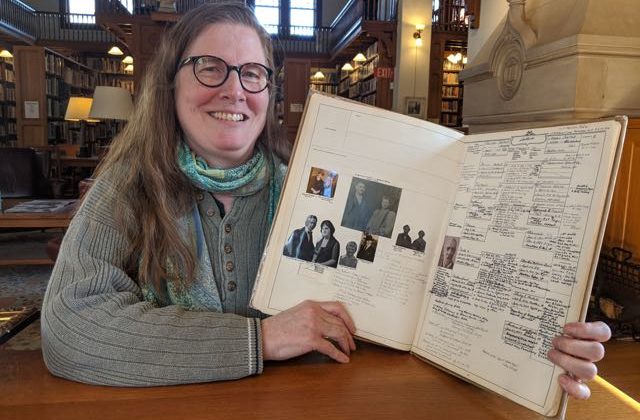A Knack for Finding Family
Text and Photo by Kelly Kandra Hughes
Imagine finding out you’re related to a witch who was accused at the time of the Salem witch trials. Or that your family heritage links back to Benjamin Franklin. Both discoveries happened during research by genealogy expert and history enthusiast Laurie Foulke-Green. In the former instance, Foulke-Green discovered that it was her own lineage that traced back to a Salem witch. In the latter, she made the discovery while researching the lineage of one of her genealogy clients. They both got a good laugh to learn her client’s exact relationship to Benjamin Franklin—first cousins, nine times removed.
Foulke-Green, who lives in Sandisfield, Mass. and works as a circulation assistant at the Norfolk Library, became interested in genealogy as a child in 1976. Not only was that the year the United States celebrated its bicentennial, but it was also when “Roots,” Alex Haley’s best-selling book, was published. “I liked being curious and learning about history,” Foulke-Green says. “My parents were also interested in genealogy and doing their own research. I liked looking through the genealogy book my mom had created.”
In 1992, after losing both her parents before the age of 22, Foulke-Green made it her goal to complete their family history. “There wasn’t much in my mom’s book,” she says, “because my grandfather was born out of wedlock.”
Foulke-Green had some information about her grandfather, Dr. Roy Voter Sanderson, a beloved physician in Winsted who delivered Ralph Nader. From Roy’s birth certificate, she knew his birth date, his mother’s name and the small Maine town where he was born. So, Foulke-Green began writing letters. She started with town halls, and from there she tracked down a book published by her long-lost relatives that included information about her great-grandmother. One hundred years after Foulke-Green’s grandfather was born, she solved the mystery of her family lineage. Her grandfather had been the result of a relationship between a hotel owner and a commercial traveler. The hotel owner gave the baby up for adoption in Boston, where he was adopted by the Sanderson family in Vermont. After attending the University of Vermont, Roy Voter Sanderson moved to Hartford, then New Hartford, before finally settling in Winsted.
Nowadays, Foulke-Green doesn’t have to rely on correspondence with town halls, 4-1-1 information, or telephone books to track down contacts. She uses resources like Ancestry.com, Fold 3 (an online database for military records), Family Search (an online database of family trees and genealogical records), and Newspapers.com. “It’s so much fun to help people find out about their ancestry. Some people don’t know anything about it. If you don’t do the research, you’ll never know who’s in your history.”
Foulke-Green knows this truth firsthand. From the information she learned about her great-grandmother, Foulke-Green started contacting distant relatives. One of them was Quentin Roosevelt DeNio, a World War II veteran who lived in Minnesota. They began writing letters to each other and corresponded until DeNio’s death in 2017. At the same time, Foulke-Green also contacted DeNio’s sister, from whom he was estranged. She received Xerox copies of their old family photos from DeNio’s niece. When Foulke-Green learned that DeNio’s grandfather had died while he was serving on the island of Saipan in the Pacific theater and that he had not been granted leave to say goodbye, she did an ink drawing of his grandfather and sent it to DeNio. DeNio placed the portrait at the top of the stairs so he could see it every morning before he went to work.
In hindsight, Foulke-Green realizes the relationship she had with DeNio gave her a family member to share her life with after her parents died. “We wrote letters for 24 years, through all the milestones. If I never had gotten interested in genealogy, I would have missed out on this wonderful connection with Quentin, my second cousin, twice removed.”

